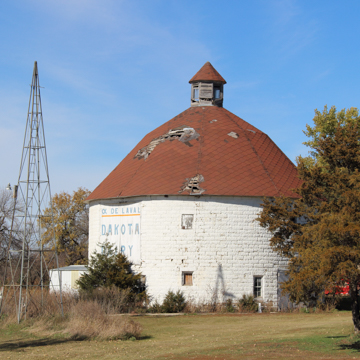The Corson Emminger Barn is a rare surviving example of a round barn in rural South Dakota. Corson Emminger built the barn in 1910, several years after moving to South Dakota from Wisconsin, where round barns were more prevalent. He purchased the farm in 1905 for $6,000 and built the barn for $1,500, presumably using it as a dairy barn.
Measuring approximately fifty feet in diameter, the round barn is constructed of concrete block and rests on a poured concrete foundation. The roof has a slight dual pitch and is clad with asphalt shingles. A polygonal cupola tops the barn, providing ventilation to the hayloft through its louvered openings; there is no internal silo. The fenestration pattern is irregular. There is a double door entrance at the ground level and a double door opening at the loft level, which was accessed via ramps.
Round barns became common throughout the Midwest in the mid-nineteenth century. Many were used for general purposes, sheltering animals and crops (usually hay), and occasionally farm implements. Some were used for specific purposes, such as dairy barns or hog barns. Round barns, including Emminger’s, were often polygonal (usually octagonal, although many varieties exist) in their actual configuration. Plans were widely available in farm journals, plan catalogues, and through state agricultural extension services. In addition, a number of companies (including Sears, Roebuck and Company, the Gordon-Van Tine Company, and others) offered mail-order kits for round and polygonal barns.
Most round barns in South Dakota were constructed between about 1910 and 1920, during a period when farms were rapidly expanding in the eastern part of the state, where farming was prevalent. Because the western half of the state was largely ranch land, a different type of barn dominated the landscape there. Barn construction declined during the 1920s due to the depressed farm economy, and by the time farmers could afford to build again after the Great Depression and World War II, technological advancements changed how barns were built and used.
In 1914, Emminger moved into nearby Watertown and sold the farm to Jacob Krull, who owned it until 1943. Krull used the round barn as a dairy barn during his entire tenure. Although it was listed on the National Register of Historic Places in 1978, the barn is no longer in use and the roof has fallen into a state of disrepair.
References
Ahrendt, Steph J. “South Dakota’s Round and Polygonal Barns and Pavilions,” Butte County, South Dakota. National Register of Historic Places Multiple Property Documentation Form, 1995. National Park Service, U.S. Department of the Interior, Washington, DC.
Erpestad, David, and David Wood. Building South Dakota. Pierre: South Dakota State Historical Society Press, 1997.

